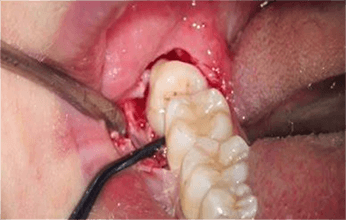What are “impacted wisdom teeth”?
In dental terminology “impacted” means that a tooth has failed to emerge fully into its expected position. This may occur either because there is not room enough in the jaw for the tooth, or else because the angulation of the tooth is improper. |
What are “wisdom teeth”?
|
| “Wisdom teeth” are a type of molar, molars are the chewing teeth found furthest in the back of the mouth. Most humans have first, second, and third molars.
Third molars, which are the “wisdom teeth”, come in behind the 2nd molars (if there is room for them and they are aligned properly) usually during a person’s late teens or early twenties. A person will have four wisdom teeth: upper left, upper right, lower left, and lower right.
|
Surgical removal of impacted wisdom teeth :
|

Impacted wisdom teeth that are causing pain or other dental problems are usually surgically removed (extracted). Extraction of a wisdom tooth is usually required for: |
| 1.Infection or gum disease (periodontal disease) involving the wisdom teeth |
| 2.Tooth decay in partially erupted wisdom teeth
3.Cysts or tumors involving the wisdom teeth
4.Wisdom teeth that are causing damage to neighboring teeth |
Classifications of impacted wisdom teeth :
|
|
Dentist use specific terms to describe the positioning of impacted wisdom teeth. The most common type of impacted wisdom teeth are those which are Mesially impacted. The term “mesial” simply means that the wisdom tooth is angled forward, towards the front of the mouth.
|
| |
| The other types of impactions, in order of occurrence, are the Vertical, Horizontal, and Distal types. |
|
In addition to Mesially, Vertically, Horizontally, and Distally impacted, wisdom teeth can also be classified as being a Soft Tissue or Bony impaction. The term “Bony” impaction indicates that the wisdom tooth is still fully encased in the jaw’s bone. A “Soft Tissue” impaction is one where the wisdom tooth has penetrated through the bone, but not yet fully through the gums.
|
| |
Why can wisdom teeth be impacted ?
|
|
The reason why wisdom teeth can be impacted is not an easy question to answer. The primary cause of wisdom tooth impaction is simply that there is inadequate jaw bone space behind the person’s second molar (the second molar comes in and is already positioned some years before the wisdom teeth erupt). Why this lack of space exists is not fully understood, however there does seem to be a correlation between large tooth size and tooth crowding and the presence of impacted wisdom teeth.
It has been theorized that the coarse nature of stone age man’s diet produced extensive tooth wear, not only on the chewing surface of the teeth but also on the aspects of the teeth which contact their neighbors. The net effect of this wear would be to reduce the collective “length” of the teeth as a set, thus providing enough jaw bone space to accommodate the wisdom teeth. In comparison the diet of modern man does not typically result in severe tooth attrition.
It has also been argued that the coarseness of stone age man’s diet, as compared to modern man’s relatively soft diet, probably required greater activity of the “chewing” muscles. This activity could have stimulated greater jaw bone growth, thus providing more space for wisdom teeth.
The rough and tumble world of the cave man no doubt often lead to broken teeth and even tooth loss. Once a tooth (or a portion of it) is missing the teeth behind it have a tendency to move forward. This shifting would make available more jaw bone space for the wisdom teeth. In comparison, with the advent of dentistry, and especially today, there are relatively few reasons why a tooth would be lost or remain unprepared.
|